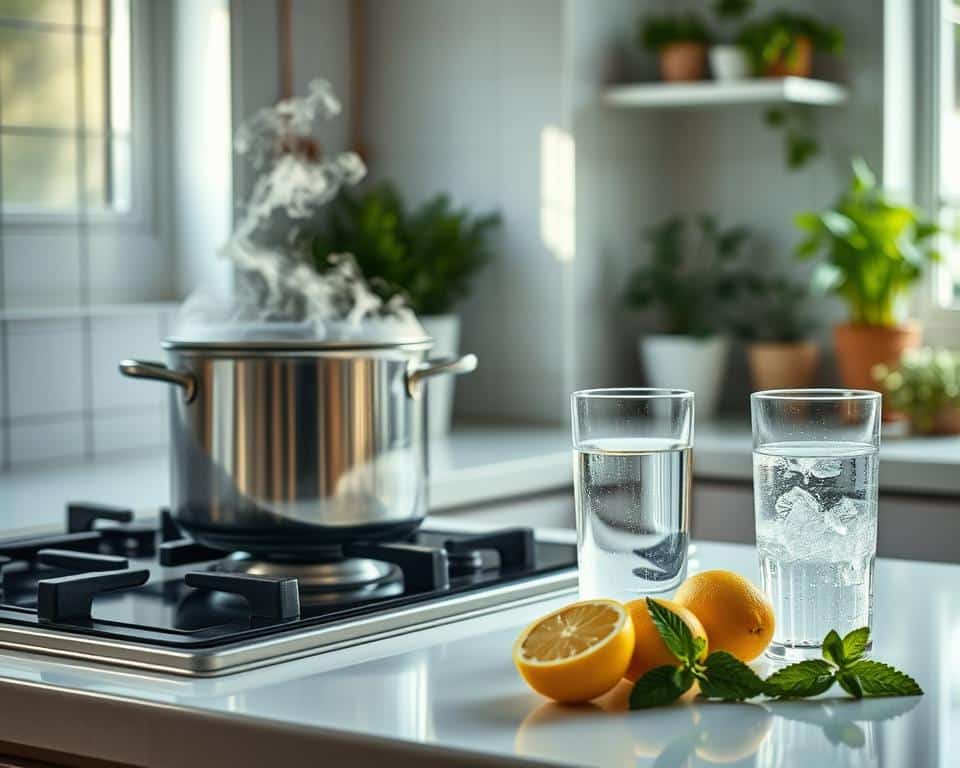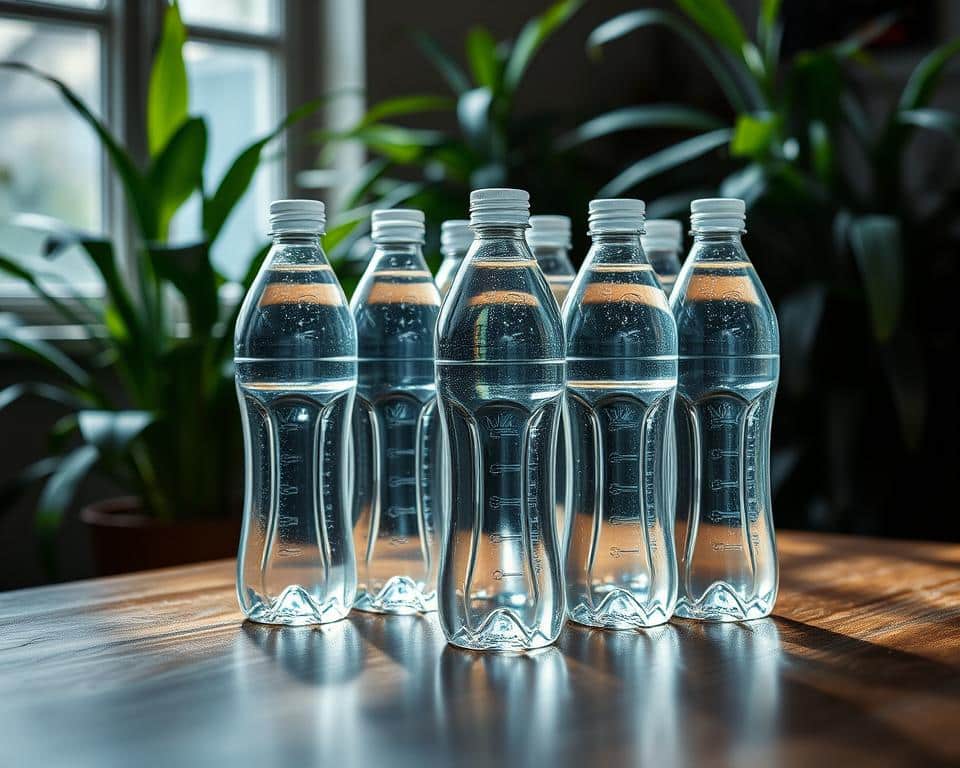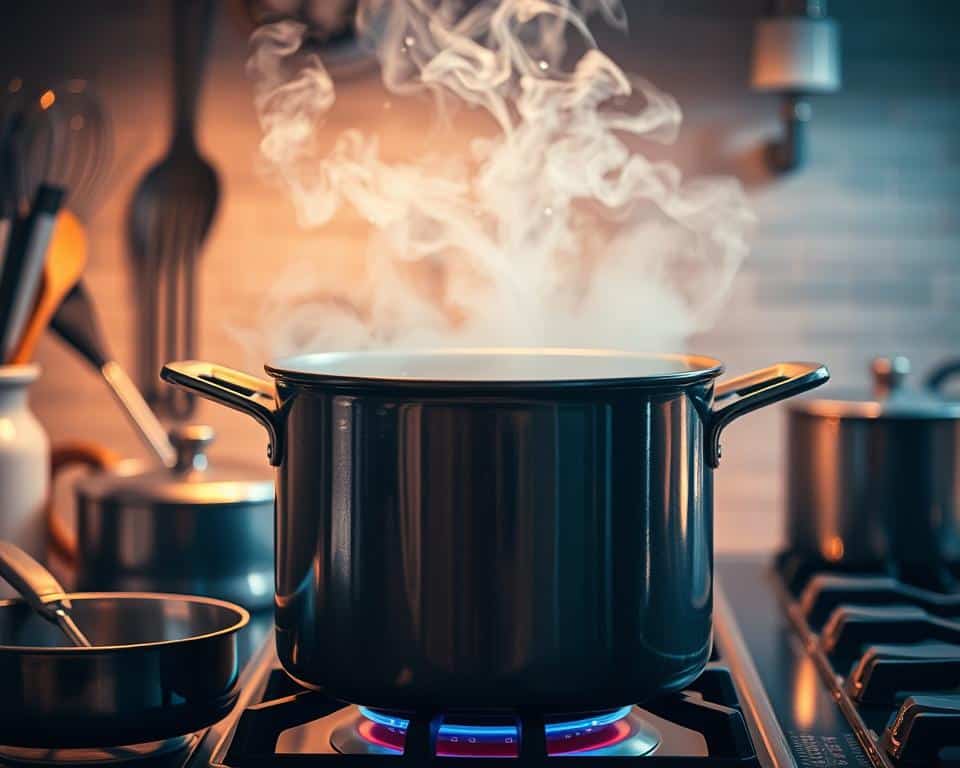Getting a boil water notice can make you worried. But it’s important to act fast to keep water safety for you and your loved ones. Authorities issue a Boil Water Advisory (BWA) if your water might be contaminated. The goal is to kill any bad germs in the water.
When you hear about a BWA, start boiling your tap water right away. This is a key step for emergency water purification. Make sure the water boils hard and keep it going for at least a minute. If you’re up high, above 6,500 feet, boil it for three minutes. After boiling, let it cool down and put it in a clean container for storage.
During a boil water notice, you should use boiled or store-bought water. This is for drinking, cooking, brushing your teeth, and even washing fruits and veggies. You should also use safe water for making baby formula, ice, and giving to your pets. Throw out any drinks, water, or ice you had made before the notice.
Also, get rid of ice from suspect water since freezing doesn’t stop bacteria. It’s okay to shower with tap water during a boil water advisory. But don’t swallow any. For washing dishes, either use a dishwasher with a high-heat or sanitizing setting. Or you can hand wash with a bit of unscented bleach in warm water.
Knowing and following these steps is key during a boil water advisory. It ensures water safety while the warning is in place.
Understanding Boil Water Advisories
Boil water advisories are key steps taken when there’s worry about water being contaminated, which could endanger public health. They warn people to boil their water before using it. This killing off any dangerous germs.
What Triggers a Boil Water Advisory?
Many situations can lead to a boil water advisory. One major cause is confirmed contamination, found during routine checks. A big drop in water pressure is another red flag.
Natural disasters like hurricanes or floods can mess up water treatment processes. This often prompts a boil water order to keep everyone safe.
Common Reasons for Issuing Advisories
These advisories usually happen due to nasty bacteria or viruses in the water. Also, problems at water treatment spots or old pipes can let pollutants into our water.
Plus, there’s a shocking number of water-main breaks—240,000 every year in the U.S. Sometimes, officials must decide between suggesting bottled water or demanding a boil water notice.
Duration and Scope of Advisories
How long a boil water advisory lasts depends on the problem. It stays until tests show the water is safe again. Sometimes, like after a spill, it could go on for a week or more.
It could affect just a few streets or the whole city. You must boil water for a minute and store it right. For more details, check out the Boil Advisory vs. Boil Order page.
- Boil water for at least one minute
- Cool and store water properly
- Flush pipes and clean equipment after advisory ends
Boil water advisories show us the big challenges our water systems face. They underline how crucial it is to stay alert to keep our drinking water clean and safe for everyone.
How to Boil Water Safely
Boiling water is key for safe drinking during a Boil Water Advisory. Precise boil water instructions help remove harmful stuff. I’m here to show you how to make sure your water is good to drink.
Step-by-Step Guide
- Start by filling a pot with water. Ensure the pot is clean and free from any contaminants.
- Place the pot on a stove and heat it until you achieve a rapid boil. You’ll notice continuous bubbles rising from the bottom to the top of the pot.
- Maintain this rapid boil for at least one minute. This duration is crucial for ensuring all potential pathogens are eradicated.
- Remove the pot from the heat source and allow the water to cool naturally. Do not add ice or any other cooling agents to expedite this process.
- Once cooled, transfer the boiled water to a clean container. Make sure the container has a secure lid to prevent any contamination.
- Store the water in a cool, dark place and use it within a reasonable time frame to maintain its safety and freshness.

Ensuring Water is Safe to Drink
It’s critical to keep your safe drinking water pure. Use it only for drinking, cooking, washing food, and brushing teeth. If contamination is suspected, boil again following the boil water instructions.
If boiling isn’t an option, use emergency disinfection methods. For clear water, add 8 drops of unscented bleach per gallon. Use 16 drops for cloudy water. Let it stand for 30 minutes before use. This offers some protection against germs.
Following these steps carefully ensures your family’s access to safe drinking water during advisories. Prioritizing this can protect against health threats from untreated water.
Alternative Methods for Safe Drinking Water
If you can’t boil tap water, other methods can keep your drinking water safe. Here’s a look at three good options:
Using Bottled Water
Bottled water is a top choice when you can’t boil water. It’s thoroughly tested to make sure it’s safe. Check out this CDC resource for more on water safety. Bottled water helps avoid waterborne illnesses and makes life easier during boil advisories.

Disinfecting Water with Bleach
Using household bleach is another way to make water safe. Here are steps for using bleach:
- Add 1/8 teaspoon of 5.25% sodium hypochlorite (household bleach) per gallon of clear water.
- Mix well and wait 30 minutes before you drink it.
- If the water’s cloudy, filter it first with a cloth or coffee filter. Then use twice the bleach.
Follow these steps to ensure the water is safe from germs. For more on using bleach, see health expert recommendations.
Choosing the Right Water Filter
Not all filters stop bacteria and viruses. Some filters can remove these dangers. Still, boiling water is best, even after filtering. After an advisory, change filters and clean the system. For help with filters during advisories, see this guide.
| Method | Effectiveness | Usage Tips |
|---|---|---|
| Bottled Water | High | Best for immediate use; ensure it’s sourced from a reputable brand. |
| Chlorine Disinfection | Moderate | Use unscented household bleach; follow proper dosage and waiting times. |
| Water Filters | Variable | Choose filters rated for bacteria/virus removal; always boil water if uncertain. |
Using Water During a Boil Water Advisory
When a boil water advisory is in place, we need to change how we use water. This ensures our safety and cleanliness. You’ll learn how to use water safely for drinking, cooking, and cleaning.
Drinking and Cooking
For drinking and cooking, only use water that has been boiled or is bottled. To boil water, heat it until it bubbles for at least one minute. If you’re higher than 6,500 feet, boil it for three minutes. This makes the water safe to drink and to use for making meals and baby formula. For extra advice, check out this detailed guide.
Personal Hygiene and Washing
Keeping clean is vital during a boil water notice. Use boiled or bottled water for washing hands or teeth and cleaning dishes. If you have a dishwasher, it’s okay to use it if it gets hot enough or has a sanitizing setting. When washing dishes by hand, soak them in a bleach solution, and then air dry.
Showering is usually okay but be careful not to swallow any water.
Pets and Household Cleanliness
Your pets also need safe water during this time. Give them boiled or bottled water to drink. Regular tap water is okay for cleaning around the house. But use safe water for washing baby bottles, toys, and surfaces. These steps keep everyone, including pets, safe.

